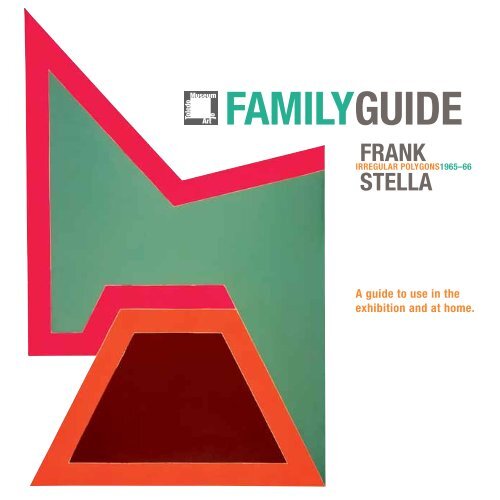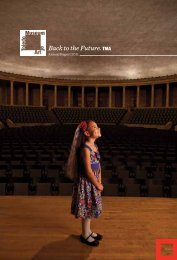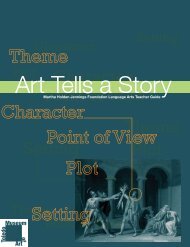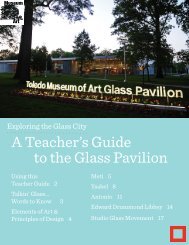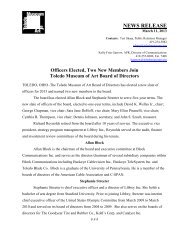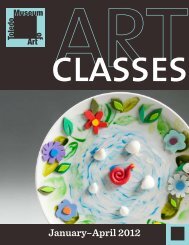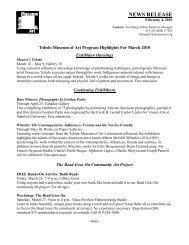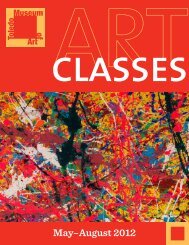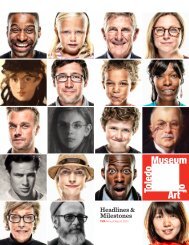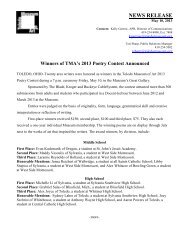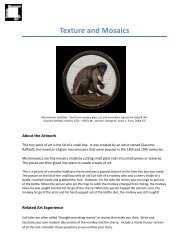familyguide frank stella - Toledo Museum of Art
familyguide frank stella - Toledo Museum of Art
familyguide frank stella - Toledo Museum of Art
You also want an ePaper? Increase the reach of your titles
YUMPU automatically turns print PDFs into web optimized ePapers that Google loves.
FAMILYGUIDEFRANKIRREGULAR POLYGONS1965–66STELLAA guide to use in theexhibition and at home.
Does a painting have to bea rectangle?Contemporary artist Frank Stella didn’t think his paintingshad to be. In this gallery you’ll notice all <strong>of</strong> the works <strong>of</strong> artare painted on canvases that have been cut and stretched tomake other shapes.Using the Family Guide, learn more about the artist FrankStella and discover how he uses the elements <strong>of</strong> shape, line,and color in his abstract works <strong>of</strong> art.Words to knowShape is a flat area, like a square or circle, that has clearbordersLine is a path made by a point moving in space, like a longmark made with a pencil.Color is what we see because <strong>of</strong> light reflecting <strong>of</strong>f <strong>of</strong> things.Close your eyes and imagine you are standing in a dark room.Do you see color?Abstract art is art that does not show objects as they appearin the world around us. Sometimes abstract art doesn’t showobjects at all—but shapes, lines, and colors placed together.
Thank you for helping us protect the art!● Feel free to sit on the floor as you talk, write, or d● Please remember not to touch works <strong>of</strong> art. do The not moisture lean on display cases, pedestals, or walls.and oils from our hands damage the art over time.● For the safety <strong>of</strong> the art, only pencils (not pens) may be usedin the museum. Please ask a member <strong>of</strong> the security andvisitor services staff if you need a pencil to do the drawingand writing activities in this family Does guide. a painting have to be a rectangle? ContemporaFrank Stella didn’t think his paintings had to be. This Fam● Please do not point at works <strong>of</strong> art with pencils or thislead you through an exploration <strong>of</strong> eleven <strong>of</strong> his shapedfamily guide. Shape: paintings What stretched onto is a irregularly Polygon? shaped frames to cr● Feel free to sit on the floor as you forms talk, write, on the or draw wall. butdo not lean on display cases, pedestals, or walls.If you were to tPolygons are closed shapes IRREGULAR that have three or more shape straight POLYGO you drewsides. Triangles, rectangles, and squares are some polygons below. Can youyou might recognize. The paintings by Frank Stella in this ecalled his Irregular Polygon series. A poDoes a painting have to be a rectangle? Contemporary artistLook at the paintings in the shape exhibition bounded to find by the straight polygons lines.Frank Stella didn’t think his paintings had to be. This Family Guide willlead you through an exploration <strong>of</strong> eleven shown below. Do you recognize any other polygons in theCan <strong>of</strong> you his shaped find these canvases— polygons in the paintings in the largpaintings stretched onto irregularly paintings? shaped topframes <strong>of</strong> the stairs? to create interestingforms on the wall.Let’s StartLooking!Let’s StartLooking!IRREGULAR POLYGONSThe paintings by Frank Stella in this exhibition areSquareRectanglecalled his Irregular Polygon series. A polygon is a flatshape bounded by straight lines.Can you find these polygons in the paintings in the large gallery at thetop <strong>of</strong> the stairs?TriangleTrapezoidChoose anothePaAn irregular polygon is made up <strong>of</strong> uneven sides and anfind some <strong>of</strong> these irregular polygons in the works?Square Rectangle Parallelogram
us protect the art!t to touch works <strong>of</strong> art. The moisturends damage the art over time.art, only pencils (not pens) may be usedse ask a member <strong>of</strong> the security andif you need a pencil to do the drawings in this family guide.at works <strong>of</strong> art with pencils or thise floor as you talk, write, or draw butlay cases, pedestals, or walls.Shape: What is an IrregularPolygon?An irregular polygon is a closed shape that has unequalsides and angles. A square is not an irregular polygon becauseBands <strong>of</strong> color run along the edge <strong>of</strong> many <strong>of</strong>it has four equal sides.these shapes. Sometimes the band goes all theway around and sometimes it leaves a sideThe paintings by Frank open. Stella Can you in this find an exhibition example are <strong>of</strong> each? called What theIrregular Polygon series.the wayThesea coloredworksshape<strong>of</strong>looks?art combine bothregular and irregular polygons. You’ll notice the shapes looklike they are layered, connected, or even pushing each otherout <strong>of</strong> the way.effect do continuous and partial bands have onWolfeboro IV, 1966, fluorescent alkyd and epoxy paints on canvas.Hirshhorn <strong>Museum</strong> and Sculpture Garden, Smithsonian Institution:Gift <strong>of</strong> Joseph H. Hirshhorn, 1972. © 2010 Frank Stella/<strong>Art</strong>ist RightsSociety (ARS), New York. Photo by Steven SlomanTrace the outside edge <strong>of</strong> each <strong>of</strong> these irregularpolygons. Find the shapes in the paintings in thisgallery.If you were to trace the outside edge <strong>of</strong> each <strong>of</strong> these paintings, theshape you drew would form an irregular polygon. Trace the outlinesbelow. Can you match them to paintings in the gallery?e a rectangle? Contemporary artistpaintings had to be. This Family Guide willration <strong>of</strong> eleven <strong>of</strong> his shaped canvases—regularly shaped frames to create interestingGULAR POLYGONStings by Frank Stella in this exhibition ares Irregular Polygon series. A polygon is a flatunded by straight lines.Choose another work in this gallery and draw its outside edge below.
LineFrank Stella uses thick lines, or bands,<strong>of</strong> color to help us see the shapes in hispaintings. Sometimes these bands goall the way around a shape, giving it anoutline. Sometimes a side is left openwithout a band.Bands may be zig-zags or look almost likeletters.Look at the paintings to find an example <strong>of</strong>:• an outline• a line that doesn’t go all the way arounda shape• a zig-zag• line that looks like a letterAdd your own lines to the irregularpolygon on this page.
ColorColor has three parts: hue, intensity, and value.• Hue is the name <strong>of</strong> the color—like blue or red.• Are the colors bright or dull? This is called the intensity <strong>of</strong>the color.• Are the colors light or dark? This is the value <strong>of</strong> the color.Frank Stella used colors <strong>of</strong> different hues, intensities, andvalues in his Irregular Polygon paintings. How he combinedthe colors makes our eyes see the shapes in certain ways—do some <strong>of</strong> them seem to pop out? Do others seem to shrinkback?Look closely at a work <strong>of</strong> art in this gallery. Pick one <strong>of</strong> thecolors in the painting and fill in the blanks in the sentencebelow to make your own colorful statement about a FrankStella painting!The _________in the painting is so _________________hue (color)the color’s intensitythat it reminds me <strong>of</strong> ___________________________!Example: The red in the painting is so bright that it remindsme <strong>of</strong> Rudolph’s nose!
Make Your Own StellainspiredIrregular PolygonAn activity to do at home: Cut along the lines <strong>of</strong> the shapesbelow and on the next page. Then put the four shapes togetherto create your own irregular polygon—or mix and match themto make two!
More Shapes to Make YourOwn Irregular PolygonAn activity to do at home: Cut along the lines <strong>of</strong> the shapesbelow. Fit the shapes together or overlap them to create newshapes. You can also color them in or add lines like FrankStella did with his paintings.
...Then Name It!The works <strong>of</strong> art in this exhibition were namedafter small towns in New Hampshire whereFrank Stella fished and camped with his fatherwhen he was a young boy.Does your Irregular Polygon remind you <strong>of</strong>somewhere you like to go or something you liketo do? Does it remind you <strong>of</strong> a favorite toy? Abuilding?Glue or tape the Irregular Polygon you made on this page, and give it a title.Title:
Who is Frank Stella?Frank Stella is an American painter and sculptor who wasborn in 1936. He has been creating works <strong>of</strong> art for over 50years! He is one <strong>of</strong> the most famous abstract artists alive.In 2010 he was given the National Medal <strong>of</strong> the <strong>Art</strong>s byPresident Barack Obama.Frank Stella in his studio, April 2009.Photo by Brian Kennedy.“The whole idea <strong>of</strong> making art is to be open, tobe generous, and absorb the viewer and absorbyourself, to let them go into it.” – Frank StellaBOMB Magazine, Spring 2000Cover: Wolfeboro IV, 1966, fluorescent alkyd and epoxy paints on canvas. Hirshhorn <strong>Museum</strong> and SculptureGarden, Smithsonian Institution: Gift <strong>of</strong> Joseph H. Hirshhorn, 1972; p. 6: Conway I, 1966, fluorescent alkyd andepoxy paints on canvas. Collection <strong>of</strong> the artist. Photo by Steven Sloman; p. 8: Sanbornville III, 1966, fluorescentalkyd and epoxy paints on canvas. Whitney <strong>Museum</strong> <strong>of</strong> American <strong>Art</strong>, New York: Gift <strong>of</strong> Joseph A. Helman, New York.Photo by Ge<strong>of</strong>frey Clements; All works ©2011 Frank Stella / <strong>Art</strong>ist Rights Society (ARS), New York.Thanks to Vivian Ladd, <strong>Museum</strong> Educator, Hood <strong>Museum</strong> <strong>of</strong> <strong>Art</strong>, Dartmouth College, for portions <strong>of</strong> this guide.© 2011 <strong>Toledo</strong> <strong>Museum</strong> <strong>of</strong> <strong>Art</strong>This exhibition was organized by the Hood <strong>Museum</strong> <strong>of</strong> <strong>Art</strong>, Dartmouth College. Special exhibitions supported in part by thegenerous members <strong>of</strong> the <strong>Toledo</strong> <strong>Museum</strong> <strong>of</strong> <strong>Art</strong> and the Ohio <strong>Art</strong>s Council.


